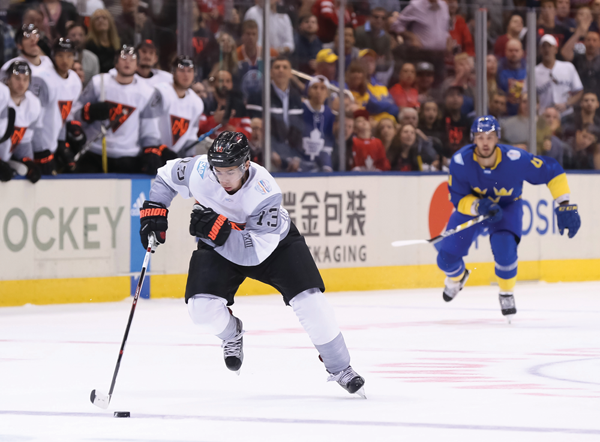After a successful test at last year’s World Cup of Hockey, the NHL is moving forward with player and puck tracking and intends to implement some of the technology in games by the end of this season.
The league is looking toward the All-Star Game weekend Jan. 27-28 in Tampa as its next public showcase of the technology. However, unlike its previous efforts, the NHL has chosen to separate player and puck tracking into two systems: an embedded chip in the puck, and computer-vision tracking for the players.
During last year’s test, overseen by Sportvision, infrared cameras installed in the rafters of Toronto’s Air Canada Centre tracked RFID chips in both the puck and the backs of jerseys to produce such metrics as location and speed of the players and puck, players’ relative distance from other players and the puck, and players’ time on the ice. That data was used editorially by the NHL and shared with tournament broadcasters ESPN and Rogers to use live during the games or intermissions.
 |
The NHL tested both puck and player tracking at last year’s World Cup of Hockey in Toronto.
GETTY IMAGES |
Sportvision also publicly tested the technology at the 2015 All-Star Game in Columbus, and the league had previously tested it privately. The NHL has spent much of the last 12 months researching and discussing the application of player tracking both internally and externally.
A computer-vision tracking system — the technology used by companies such as Second Spectrum and SportVU and most notably now in hockey by Montreal-based Sportlogiq — would provide the league with an accurate tracking system that’s easier to begin using and less expensive than a chip-based player tracking system.
Vision-based tracking systems aren’t feasible for tracking the puck, because of its speed, unpredictable movement and tendency to be covered up by a goalie.
The NHL is talking with one or two potential vendors that can provide each of these individual technologies, said David Lehanski, NHL senior vice president of business development and global partnerships. He declined to name them.
Lehanski said the NHL’s goal is to again test the technologies at the All-Star Game, and potentially begin to roll out the computer-vision tracking system by the end of the season and into the playoffs. For puck tracking, the current goal is to have the system roll out at some point for the 2018-19 season.
Any use of player or puck tracking would require approval by the NHLPA as well.
“With player and puck tracking, we believe there is an opportunity to take some of the ‘oohs and aahs’ you hear in an arena when people see the speed and skill of the players live, and bring that to people on their couches and help them feel it,” said Lehanski, who is overseeing the league’s push into technological solutions alongside Chief Technology Officer Peter DelGiacco and Steve McArdle, chief administrative officer and executive vice president of strategic planning.
For avid fans, Lehanski said, “we believe this is going to create a whole new offering of data and analytics.”
The NBA and NFL have player tracking deals with Second Spectrum and Zebra Technologies, respectively, and MLB uses its own proprietary system developed by MLBAM called Statcast. While the NHL would not speculate on how much a leaguewide installation of a tracking system would cost, MLB has previously said it cost the league tens of millions to roll out Statcast in 2015.
The NHL has lagged behind the other leagues largely because of the difficulty presented by the speed of hockey itself. But the NHL made early inroads in tracking in 1996 with then broadcast partner Fox Sports with the FoxTrax puck tracker, technology that was mocked at its launch but is now viewed as an innovation ahead of its time.



